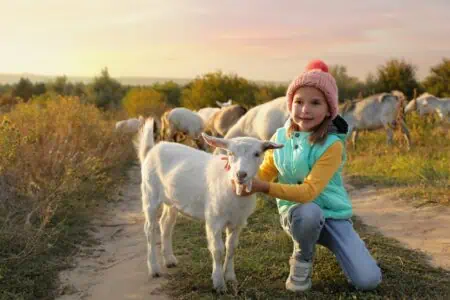If you’ve got an animal-obsessed kiddo, then a few rounds of animal trivia is a fun way to keep them entertained. Whether you’ve got a long drive ahead, are hosting an animal-themed birthday party, or are planning a games night, animal trivia is a paw-some way to have fun while learning about nature!
We’ve assembled 175 animal trivia questions with answers across various topics — easy trivia, hard questions, marine animals, household pet trivia, and more! Test your children’s knowledge of creatures with these exciting challenges while growing your own knowledge simultaneously.
Easy Animal Trivia

Starting with simple questions for the pups! These 22 questions are great for younger kids or children who are new to the world of exploring animals.

What is the tallest animal in the world?
Answer: A giraffe.
Fun Fact: Giraffes have the same number of neck vertebrae as humans—seven. However, each vertebra in a giraffe’s neck can be over 10 inches long!

What fish blows up like a balloon when threatened?
Answer: A pufferfish.
Fun Fact: Pufferfish contain a deadly toxin called tetrodotoxin, which is 1,200 times more poisonous than cyanide.

What animal has orange fur and black stripes?
Answer: A tiger.
Fun Fact: No two tigers have the same pattern of stripes, making each tiger unique, much like human fingerprints.

What is the largest land animal?
Answer: An elephant.
Fun Fact: Elephants are known for their incredible memory. They can remember locations of water sources and recognize other elephants even after years of separation.

What animal hops and carries a baby in its pouch?
Answer: A kangaroo.
Fun Fact: Kangaroos can hop at speeds of up to 35 miles per hour and use their powerful tails for balance while hopping.

What is a doe?
Answer: A female deer.
Fun Fact: A doe can be very protective of their fawns and use their sharp hooves to fend off predators.

What animal is known as a man’s best friend?
Answer: A dog.
Fun Fact: Dogs have been domesticated for over 14,000 years, making them one of the first animals to live alongside humans.

What do you call a baby dog?
Answer: A puppy.
Fun Fact: Puppies are born blind, deaf, and toothless. They start to see and hear around two weeks of age.

What is a baby sheep called?
Answer: A lamb.
Fun Fact: Lambs have a remarkable sense of smell and can recognize their mother’s scent almost immediately after birth.

What is a kitten?
Answer: A baby cat.
Fun Fact: Kittens are born with their eyes closed and only open them after about seven to ten days.

What insect can light up at night?
Answer: A firefly.
Fun Fact: Fireflies use their bioluminescence to attract mates and communicate with each other.

What kind of animal is a German Shepherd?
Answer: A dog.
Fun Fact: German Shepherds are highly intelligent and versatile, often used in police and military roles worldwide.

What does a snake shed a few times a year?
Answer: Its skin.
Fun Fact: Shedding their skin allows snakes to grow and remove parasites that may have attached to their old skin.

How many tentacles does an octopus have?
Answer: Eight.
Fun Fact: Octopuses have three hearts and blue blood, which helps them survive in the ocean’s depths.

What is a foal?
Answer: A baby horse.
Fun Fact: Foals can stand and walk within hours of birth, a crucial survival trait in the wild.

What animal has a long neck and spots?
Answer: A giraffe.
Fun Fact: Giraffes only need to drink water every few days; they get most of their moisture from the leaves they eat.

What is an amphibian?
Answer: An animal that can live on land and in water.
Fun Fact: Amphibians, like frogs, often start life in water as tadpoles before developing into their adult forms and moving onto land.

What noise does an owl make?
Answer: “Hoo-hoo.”
Fun Fact: Owls can rotate their heads up to 270 degrees, giving them a wide range of vision without moving their bodies.

How many lives is a cat known to have?
Answer: Nine.
Fun Fact: This myth likely originated from cats’ ability to escape seemingly deadly situations due to their agility and reflexes.

What animal has a trunk and big ears?
Answer: An elephant.
Fun Fact: Elephants use their trunks for breathing, smelling, drinking, and grabbing objects, making them one of the most versatile animal body parts.

What creature is known as the king of the jungle?
Answer: A lion.
Fun Fact: Lions are the only big cats that live in social groups called prides, which can consist of up to 40 members.

What is the fastest land animal?
Answer: A cheetah.
Fun Fact: Cheetahs can accelerate from 0 to 60 miles per hour in just a few seconds, making them the fastest land animals over short distances.
Hard Animal Trivia

Ready to level up to more difficult animal trivia questions? Below are 22 more challenging questions to test the brain — great for adults. Beware: there are some weird ones here.

What is the largest living primate?
Answer: A gorilla.
Fun Fact: Gorillas share about 98% of their DNA with humans, making them one of our closest living relatives in the animal kingdom.

What mammal has the most powerful bite?
Answer: A hippo.
Fun Fact: Despite their massive jaws and powerful bite, hippos primarily eat grass and are considered herbivores.

What bird only eats bones?
Answer: A bearded vulture.
Fun Fact: The bearded vulture, also known as the lammergeier, has stomach acid with a pH close to 1, allowing it to digest bones easily.

What is the largest zoo in the United States of America?
Answer: The North Carolina Zoo.
Fun Fact: The North Carolina Zoo spans over 2,600 acres, making it one of the largest natural habitat zoos in the world.

What animal can squirt blood from its eyes to defend itself?
Answer: A Texas Horned Lizard.
Fun Fact: The Texas Horned Lizard can shoot blood up to five feet from its eyes to deter predators, a unique and effective defense mechanism.

What is the only mammal that can fly?
Answer: A bat.
Fun Fact: Bats are essential for the environment as they help control insect populations and pollinate plants.

What animal is known as the unicorn of the sea?
Answer: A narwhal.
Fun Fact: The narwhal’s tusk is a long, spiral tooth that can grow up to 10 feet long and is used for sensing the environment.

What is the name of a group of 15 or more cows?
Answer: A flink.
Fun Fact: Cows have strong social bonds and can form close friendships with other cows in their group.

What color are reindeer’s eyes during winter?
Answer: Blue.
Fun Fact: Reindeer’s eyes change color from gold in the summer to blue in the winter to help them see in the low light conditions of the Arctic.

What animal can move its eyes independently for 360-degree vision?
Answer: A chameleon.
Fun Fact: Chameleons can change their skin color not only for camouflage but also to communicate with other chameleons and regulate their body temperature.

What animal has over 40,000 muscles in their nose?
Answer: An African Elephant (in their trunk).
Fun Fact: An elephant’s trunk is so sensitive and dexterous that it can pick up a single blade of grass and be strong enough to rip branches off a tree.

What is the name of a male and female rabbit?
Answer: A buck and a doe.
Fun Fact: Rabbits have a unique digestive system that allows them to extract more nutrients from their food by eating their fecal pellets, a process called coprophagy.

What is the scientific name for a polar bear?
Answer: Ursus maritimus.
Fun Fact: Polar bears have black skin under their white fur to better absorb the sun’s heat and keep them warm in the Arctic cold.

How much milk does a dairy cow produce a day?
Answer: About six or seven gallons (on average).
Fun Fact: A single cow can produce over 2,000 gallons of milk in a year, providing a vital source of nutrition for humans.

Where is the heart of a shrimp located?
Answer: In its head.
Fun Fact: Shrimp have an open circulatory system, meaning their organs float directly in blood rather than being contained in blood vessels.
What are the three classes of amphibians?
Answer: Anura/Salientia, Urodela/Caudata, and Gymnophiona.
Fun Fact: Amphibians are excellent indicators of environmental health because their permeable skin makes them sensitive to environmental changes.

What animal makes up a group of a prickle or array?
Answer: Hedgehogs.
Fun Fact: Hedgehogs can roll into a tight ball, using their spines to defend themselves against predators.

How fast can a hippo run on land?
Answer: Between 19 and 28 miles per hour.
Fun Fact: Despite their bulk and short legs, hippos are surprisingly fast runners and can easily outrun humans over short distances.

What is the study of animals called?
Answer: Zoology.
Fun Fact: Zoologists often specialize in studying specific groups of animals, such as entomologists who study insects or herpetologists who study reptiles and amphibians.
How long is the pregnancy of a black panther?
Answer: Three months.
Fun Fact: Black panthers are not a separate species but a melanistic variation of leopards and jaguars, meaning they have a high amount of black pigment in their fur.

How many vertebrae are in a giraffe’s neck?
Answer: Seven.
Fun Fact: Despite their long necks, giraffes have the same number of neck vertebrae as most mammals, including humans.

What is the largest species of penguin?
Answer: Emperor penguin.
Fun Fact: Emperor penguins can dive to depths of over 1,800 feet and hold their breath for over 20 minutes while hunting for food.
Funny Animal Quiz Questions

To give your brain a break from the hard trivia questions, here are 21 funny animal quiz questions to keep you guessing. Perfect for kids who love a laugh — how many can you guess right?

How long does it take a sloth to digest a leaf?
Answer: 30 days.
Fun Fact: Sloths have a very slow metabolic rate, which helps them survive on a low-energy diet of leaves.

How many hours a day does a koala sleep?
Answer: 20.
Fun Fact: Koalas sleep so much because their diet of eucalyptus leaves provides very little energy and is difficult to digest.

What color is a hippo’s sweat?
Answer: A red-orange color.
Fun Fact: Hippo sweat contains natural sunscreen and antibacterial properties, helping them stay cool and protected from the sun.

What animal creates a banana scent when it stings?
Answer: Bees.
Fun Fact: The banana scent is due to the presence of isoamyl acetate, a compound also found in bananas, which acts as a pheromone to alert other bees of danger.

How many eyelids does a dog have?
Answer: Three.
Fun Fact: A dog’s third eyelid, called the nictitating membrane, helps protect their eyes and keep them moist.

What animal can catch the human cold?
Answer: Gorillas.
Fun Fact: Gorillas can also suffer from many diseases like humans, including respiratory infections and even heart disease.

What animal gives their potential partner a pebble as a gift?
Answer: Penguins.
Fun Fact: Male penguins often give pebbles to females as part of their courtship ritual, and these pebbles are used to build their nests.

How long have cockroaches been around?
Answer: 280 million years.
Fun Fact: Cockroaches are incredibly resilient and can survive without food for a month and without their head for up to a week.

What animal can we determine its age by its earwax?
Answer: A whale.
Fun Fact: Whale earwax, or cerumen, accumulates in layers over time, providing a timeline of the whale’s age and exposure to pollutants.

What animal feeds its babies from milk oozing out its skin?
Answer: A duck-billed platypus.
Fun Fact: The platypus doesn’t have nipples; instead, it secretes milk through specialized mammary gland ducts in its skin, which the young lap up directly from the mother’s fur.

What animal sometimes does a handstand when peeing?
Answer: A panda.
Fun Fact: Pandas use this unique handstand behavior to mark their territory with urine at higher points, making their scent marks more noticeable to other pandas.

What bird can’t fly but can run super fast?
Answer: An ostrich.
Fun Fact: Ostriches can run at speeds of up to 45 miles per hour, making them the fastest birds on land.

What flying insect can recognize human faces?
Answer: Bees.
Fun Fact: Bees use a process called configural processing, similar to humans, to recognize and remember individual faces.

What color is a polar bear’s skin?
Answer: Black.
Fun Fact: A polar bear’s black skin helps absorb heat from the sun, while their transparent fur appears white and provides camouflage in the snow.

What animal, without teeth, uses gravel to help itself chew food?
Answer: A duck-billed platypus.
Fun Fact: Platypuses store gravel and mud in their cheek pouches, which they use to grind up their food since they lack teeth.

What hopping animal doesn’t have pads on its paws?
Answer: Rabbits (they only have fur).
Fun Fact: A rabbit’s fur-covered feet help them move silently and protect their paws from rough terrain.

What animal can taste the air via their vomeronasal organ?
Answer: Cats.
Fun Fact: Cats use their vomeronasal organ, or Jacobson’s organ, located on the roof of their mouth, to detect pheromones and other scent molecules in the air.

What dog has a black tongue?
Answer: The Chow Chow.
Fun Fact: Chow Chows and Shar-Peis are the only two dog breeds known to have blue-black tongues, a unique trait.

What sea animal gives each other unique names?
Answer: Dolphins.
Fun Fact: Dolphins use distinct signature whistles to identify and communicate with each other, similar to how humans use names.

What small animal greets each other with nose-to-nose contact (which looks like a kiss)?
Answer: Squirrels.
Fun Fact: Squirrels use these nose-to-nose greetings to gather information about each other, such as health and reproductive status.

What arthropod animal has taste buds on its feet?
Answer: Crabs.
Fun Fact: Crabs use their taste-sensitive feet to explore their environment and find food by walking on and tasting it.
Marine Animal Trivia

Test your friend’s and family’s knowledge of marine animals, including cetaceans, pinnipeds, sirenians, and marine fissipeds. Let’s see if they knew all four of these species to start with.

What percentage of living creatures live in the ocean?
Answer: 15%.
Fun Fact: Oceans cover more than 70% of Earth’s surface, yet we have explored less than 5% of them, leaving much of the marine life undiscovered.

How many mates do angelfish have in their lifetime?
Answer: One.
Fun Fact: Angelfish form monogamous pairs and are known to protect their chosen mate and territory fiercely.

What marine animal pees from its face?
Answer: Lobsters.
Fun Fact: Lobsters communicate by squirting urine from openings near their eyes, which helps them establish dominance and attract mates.

How many species of fish are there?
Answer: About 33,600 known species.
Fun Fact: New fish species are being discovered every year, highlighting the incredible diversity of marine life.

What is the largest mammal in the world?
Answer: The Blue Whale.
Fun Fact: The heart of a blue whale is so large that a human can swim through its arteries, and it can weigh as much as a car.

What type of animal was crocodile hunter Steve Irwin killed by?
Answer: A stingray.
Fun Fact: Stingrays are generally not aggressive and use their barbed tails primarily for defense when threatened.

How many arms does a squid have?
Answer: Ten (two tentacles and eight arms).
Fun Fact: Squids use their two longer tentacles to capture prey, while the shorter eight arms help them hold and manipulate it.

What is the study of fish called?
Answer: Ichthyology.
Fun Fact: Ichthyologists study everything about fish, from their biology and behavior to their role in ecosystems and their importance to humans.

What is a group of dolphins called?
Answer: A pod.
Fun Fact: Dolphins live in complex social groups called pods, which can consist of a few individuals to over a thousand.

What is a group of jellyfish called?
Answer: A fluther, bloom, or smack.
Fun Fact: Jellyfish blooms can be so large that they are visible from space, and some blooms contain millions of individuals.

What sea animal gets dementia after mating?
Answer: Octopuses.
Fun Fact: After mating, many octopus species rapidly decline in health, leading to behaviors resembling dementia in humans.

What color is an uncooked lobster?
Answer: Lobsters are usually mottled-brown.
Fun Fact: Lobsters only turn red when they are cooked. Otherwise, they are usually brown, though some are blue, orange, or gray.

What marine animal can change its skin color and texture to camouflage with its surroundings?
Answer: A cuttlefish.
Fun Fact: Cuttlefish have specialized cells called chromatophores that allow them to change color rapidly and blend in with their environment.

What marine animal gets its name from an earth flower and lives on the seafloor to capture prey?
Answer: Anemone.
Fun Fact: Sea anemones have a symbiotic relationship with clownfish, which are immune to the anemone’s stinging tentacles and provide protection from predators.
What is the fastest fish in the world, swimming up to 68 miles per hour?
Answer: Indo-Pacific Sailfish.
Fun Fact: The sailfish’s speed is aided by its streamlined body and large, sail-like dorsal fin, which help it maneuver quickly through the water.

What sea does the European Eel spawn in?
Answer: Sargasso Sea.
Fun Fact: European eels migrate thousands of miles from their freshwater homes to the Sargasso Sea in the Atlantic Ocean to spawn, a journey that takes several months.

What is the largest marine animal with a whistle that can travel up to 500 miles?
Answer: The Blue Whale.
Fun Fact: Blue whales communicate using low-frequency whistles that can travel hundreds of miles underwater, allowing them to stay in contact over vast distances.

What makes up soft white sand on the beaches of Hawaii?
Answer: Parrotfish poop — the fish scrape algae off rocks and corals, grind it up in their gut and poop it out as sand.
Fun Fact: Parrotfish play a crucial role in coral reef ecosystems by helping to keep algae levels in check and contributing to the formation of sandy beaches.

What marine animal has three hearts and blue blood?
Answer: Octopus.
Fun Fact: Octopus blood is blue because it contains a copper-based molecule called hemocyanin, which is more efficient at transporting oxygen in cold, low-oxygen environments.

What species of jellyfish is considered immortal since it can revert its cells back to the earliest form?
Answer: Turritopsis dohrnii.
Fun Fact: The “immortal” jellyfish can reverse its aging process by reverting to its juvenile polyp stage, allowing it to live indefinitely under the right conditions.

How loud (in decibels) can the piston shrimp be when it uses its claws?
Answer: Up to 210 decibels.
Fun Fact: The pistol shrimp creates a sound so loud that it can stun prey and even break glass, making it one of the loudest animals in the ocean.

What marine animal has blue blood used by medical researchers to try out new medicines?
Answer: The horseshoe crab.
Fun Fact: Horseshoe crab blood contains a unique substance called Limulus Amebocyte Lysate (LAL), which is used to test for bacterial contamination in medical equipment and vaccines.
Endangered Species Trivia

It’s important to learn about endangered species. Sadly, various animals across the world are becoming endangered due to habitat loss and loss of genetic variation. See how well you understand endangered species with these 22 animal trivia questions.

What animals, once endangered, eventually became extinct about 65 million years ago because of an asteroid hitting Earth?
Answer: Dinosaurs.
Fun Fact: Dinosaurs ruled the Earth for over 160 million years before their sudden extinction, which allowed mammals to become the dominant land animals.

Name the endangered animal that mostly eats plants but also likes to lick metals.
Answer: Panda.
Fun Fact: Pandas have a special wrist bone that acts like a thumb, allowing them to grasp bamboo stalks more easily.

What herbivore, known for its black and white markings, is poached for its horn?
Answer: The Javan rhinoceros.
Fun Fact: The Javan rhinoceros is one of the rarest large mammals worldwide, with only about 60 individuals left in the wild.

What percentage of bird species are currently endangered or threatened?
Answer: 13.5% (1,481 of 11,000 species).
Fun Fact: Habitat destruction and climate change are major threats to bird populations, but conservation efforts are helping to protect many endangered species.

Of these three animals — Amur tiger, Tasmanian tiger, and Wolverine — which is extinct?
Answer: Tasmanian tiger.
Fun Fact: The Tasmanian tiger, or thylacine, was the largest carnivorous marsupial and became extinct in the 20th-century due to hunting and habitat loss.

In which river do the critically endangered Chinese alligators live?
Answer: The Yangtze River.
Fun Fact: The Chinese alligator is much smaller than the American alligator and is one of the most endangered reptiles in the world.

How many hours per day do pandas spend eating?
Answer: 10 to 16.
Fun Fact: Pandas have to eat so much because bamboo, their primary food source, is low in nutrients and requires a lot of consumption to meet their energy needs.

How many species are predicted to be extinct by 2050?
Answer: One million.
Fun Fact: This alarming prediction highlights the urgent need for global conservation efforts to protect biodiversity and prevent mass extinctions.

Sperm Whales have been endangered since 1970, but their population is increasing. In 1995, there were an estimated minimum of 226 in the North Atlantic. What was the estimated population in 2016?
Answer: 4,349.
Fun Fact: Sperm whales can dive to depths of over 3,000 feet and hold their breath for up to 90 minutes while searching for squid, their primary food source.

What gorilla species, located in Africa, has only about 1,000 left in the population?
Answer: Mountain gorilla.
Fun Fact: Mountain gorillas live in the dense forests of the Virunga Mountains and Bwindi Impenetrable National Park, sharing about 98% of their DNA with humans.

How fast can a tiger run?
Answer: Up to 40 mph.
Fun Fact: Tigers are powerful swimmers and enjoy cooling off in water, which sets them apart from many other big cats.

How many species of animals are threatened with extinction?
Answer: 44,000.
Fun Fact: The IUCN Red List is a comprehensive inventory that provides the conservation status of species worldwide, helping guide conservation efforts.

What species make up the majority of animals threatened with extinction?
Answer: Amphibians (41%).
Fun Fact: Amphibians are particularly vulnerable to environmental changes and pollutants due to their permeable skin, making them key indicators of ecosystem health.

What is the primary threat to the survival of vaquita, a small porpoise species?
Answer: Illegal fishing.
Fun Fact: The vaquita, found only in the northern Gulf of California, is the world’s most endangered marine mammal, with fewer than 20 individuals remaining.

What is the main threat of endangerment for sea turtles?
Answer: Getting entangled in fishing gear.
Fun Fact: Sea turtles have existed for over 100 million years, but today, all seven species are threatened or endangered due to human activities.

How many elephants are killed for their tusks every day?
Answer: 100.
Fun Fact: Elephant tusks are highly sought after for ivory, leading to widespread poaching and a significant decline in elephant populations.

What large canine, native to Eurasia and North America, became extinct in Scotland in the 1600s?
Answer: The wolf.
Fun Fact: Efforts are underway to reintroduce wolves to certain areas, recognizing their importance in maintaining healthy ecosystems.

What endangered animal does the World Wildlife Fund use as their logo?
Answer: The giant panda.
Fun Fact: The giant panda’s distinct black-and-white fur makes it one of the most recognizable and beloved endangered species worldwide.

How many countries does the Asian elephant inhabit?
Answer: 13.
Fun Fact: Asian elephants are smaller than their African counterparts and have a single “finger” on the end of their trunk, compared to the African elephant’s two.

What endangered bird is the tallest in America?
Answer: The whooping crane.
Fun Fact: Whooping cranes are one of North America’s most endangered birds, and intensive conservation efforts are slowly increasing their population.

What is the most trafficked animal in the world?
Answer: Pangolins.
Fun Fact: Pangolins are often called “scaly anteaters” because of their protective keratin scales. They play a crucial role in pest control by eating ants and termites.

Why do humans capture sun bears?
Answer: To be kept as pets.
Fun Fact: Sun bears, the smallest bear species, are known for their long tongues, which they use to extract honey from beehives.
Household Pet Trivia

On the other end of the spectrum, household pets are increasingly being bred for humans to keep in their homes. The following animal trivia questions are a great way to test your knowledge of this part of the animal kingdom. These are great for jeopardy-themed game nights or keeping kiddos entertained — it’s time to get your game face on!

What rodent is often kept as a pet and comes in breeds such as Syrian and Dwarf?
Answer: Hamster.
Fun Fact: Hamsters are nocturnal, meaning they are most active at night, which is why they love running on their wheels while you’re trying to sleep.

By what percentage can a pet reduce its owner’s mortality rate?
Answer: 24%
Fun Fact: Pets not only provide companionship but also encourage physical activity and reduce stress, leading to better overall health for their owners.

Where do dogs sweat from?
Answer: Their paw pads.
Fun Fact: Dogs also regulate their body temperature by panting, as they have fewer sweat glands than humans.

How many breeds of dogs are there, as recognized by the Fédération Cynologique Internationale (FCI)?
Answer: 339
Fun Fact: The diversity in dog breeds is due to selective breeding for specific traits, resulting in a wide range of sizes, shapes, and temperaments.

What is the first sense that a dog develops?
Answer: Touch.
Fun Fact: Newborn puppies are born blind and deaf but quickly develop a keen sense of touch to navigate their surroundings and bond with their mother.

How many layers make up a dog’s coat?
Answer: Two.
Fun Fact: Dogs have an undercoat for insulation and an outer coat for protection against the elements, which is why regular grooming is essential for their health.

Which pet can mimic human speech?
Answer: Parrots.
Fun Fact: Parrots have complex vocal cords and a high level of intelligence, allowing them to mimic sounds and even learn to understand some words and phrases.

How many times their body length can a cat jump?
Answer: Five to six.
Fun Fact: A cat’s powerful hind leg muscles and flexible spine enable them to make impressive leaps, often reaching heights up to six times their body length.

What is the fastest breed of dog?
Answer: The greyhound (45 mph).
Fun Fact: Greyhounds have been bred for speed and agility, making them excellent racing dogs, but they are also known for being gentle and loving pets.

What gender is the majority of Calico cats?
Answer: Female.
Fun Fact: The unique tri-color pattern of Calico cats is linked to the X chromosome, making nearly all Calico cats female due to the genetics of coat color.

What breed of herding dog originated in the Shetland Islands of Scotland?
Answer: The Shetland sheepdog (Sheltie).
Fun Fact: Shetland sheepdogs, or Shelties, are known for their intelligence and agility, making them excellent competitors in dog sports and herding trials.

What breed of dog is associated with firehouses and known for its loyalty?
Answer: Dalmatian.
Fun Fact: Dalmatians were initially bred as carriage dogs, running alongside horse-drawn carriages to protect them, which is why they became associated with firehouses.

What percentage of its body weight must a parrot eat per day?
Answer: 10 to 15%.
Fun Fact: Parrots have a high metabolism and require a varied diet of seeds, nuts, fruits, and vegetables to stay healthy and active.

How long did the oldest pet goldfish live?
Answer: 43 years.
Fun Fact: The record for the oldest goldfish, named Tish, was held by a fish that lived from 1956 to 1999. This proves that with proper care, goldfish can have remarkably long lifespans.

How long did the oldest pet dog live?
Answer: 31 years.
Fun Fact: The oldest recorded dog, Bluey, was an Australian cattle dog who lived from 1910 to 1939 and worked as a herding dog for over 20 years.

There are approximately between 60 and how many million feral cats in the U.S.A.?
Answer: 100 million.
Fun Fact: Feral cats often form colonies and can live in various environments, from urban areas to rural landscapes, relying on their instincts to survive.

What dog breed, known for its long ears, was historically used for tracking humans and hunting deer?
Answer: Bloodhounds.
Fun Fact: Bloodhounds have an incredible sense of smell, with up to 300 million scent receptors, making them one of the best tracking dogs in the world.

What type of pet is the Abyssinian?
Answer: A cat.
Fun Fact: Abyssinians are one of the oldest known cat breeds. They are believed to have originated from ancient Egypt and are known for their playful and affectionate nature.

What quirky thing are hamsters known for doing with their eyes?
Answer: Winking (or blinking one eye at a time).
Fun Fact: Hamsters have poor eyesight and rely more on their sense of smell and touch to navigate their environment.

What celebrity’s dog, named Tinkerbell, had her own memoir?
Answer: Paris Hilton.
Fun Fact: Tinkerbell, a Chihuahua, was a frequent companion to Paris Hilton and became a fashion icon in her own right, popularizing the trend of small dogs as accessories.
What white drink should you never give to a cat?
Answer: Cow’s milk.
Fun Fact: Most adult cats are lactose intolerant, meaning they cannot properly digest the lactose in cow’s milk, which can cause stomach upset and digestive issues.

What is the smallest breed of dog?
Answer: Chihuahua.
Fun Fact: Chihuahuas are named after the Mexican state of Chihuahua, and despite their small size, they are known for their bold and feisty personalities.
Guess the Animal Trivia

In this section, we will give you a clue or two about some of nature’s finest creatures, and you have to guess what they are. Let’s get started with this fun trivia section!

This long-nosed mammal lays eggs instead of giving birth.
Answer: Duck-billed platypus.
Fun Fact: Along with the echidna, the platypus is one of the only mammals that lay eggs, a trait known as monotremy.

This marine mammal has white fur and can swim for days at a time.
Answer: Polar bear.
Fun Fact: Polar bears are excellent swimmers and can travel more than 60 miles in one stretch to find food or reach new ice floes.

This ground-dwelling animal usually lives in troops of up to 200 animals. The males leave their group around puberty, and the females remain with their group their entire life.
Answer: Baboon.
Fun Fact: Baboons have complex social structures and are known for their vocal communication, which includes a variety of barks, grunts, and screams.

Despite the tendency to be messy, this pink farm animal is actually very clean.
Answer: Pig.
Fun Fact: Pigs are highly intelligent animals that use mud baths to cool off, protect their skin from the sun, and remove parasites.

This animal is known as the “Mexican walking fish” and can regenerate body parts.
Answer: Axolotl.
Fun Fact: Axolotls are unique among amphibians for their ability to regenerate limbs, spinal cord, heart, and other organs, even in adulthood.

This social animal loves playing hide and seek, but they have poor eyesight.
Answer: Ferret.
Fun Fact: Ferrets have been domesticated for over 2,500 years and were originally used for hunting rabbits and rodents.

This animal moves so slowly that algae grow on its fur, but that helps them with camouflage.
Answer: Sloth.
Fun Fact: Sloths have a low metabolic rate and sleep up to 20 hours a day, conserving energy by moving slowly.

This toothless animal has a tongue so long it can lap up 35,000 insects each day. It’s gray-brown in color and typically found throughout South and Central America.
Answer: Anteater.
Fun Fact: Anteaters have specialized tongues covered in sticky saliva that allows them to capture and consume large quantities of ants and termites efficiently.

This animal has a long tusk that is actually an elongated tooth that can grow up to ten feet.
Answer: Narwhal.
Fun Fact: Narwhal tusks have sensory capabilities, allowing the narwhal to detect changes in the environment, such as temperature and pressure.

This wild dog species is an omnivore, mates for life, and runs as fast as 43 miles per hour.
Answer: Coyote.
Fun Fact: Coyotes are highly adaptable and can thrive in a variety of environments, including urban areas where they often come into contact with humans.

This animal has large ears that dissipate heat but allow them to hear prey underground.
Answer: Fennec fox.
Fun Fact: Fennec foxes are the smallest of all fox species and are well-adapted to life in the Sahara Desert, where their large ears help them stay cool and locate food.
This animal has dark spots on its fur called rosettes since they’re shaped like a rose.
Answer: Leopard.
Fun Fact: Leopards are highly versatile predators and can adapt to a wide range of habitats, from rainforests to savannas to urban areas.

This animal can be found all over the planet except in extreme deserts or polar regions. The biggest threat to their existence is a disease called white-nose syndrome.
Answer: Bats.
Fun Fact: Bats are the only mammals capable of sustained flight and play crucial roles in pollination and pest control.

This insect is the only one that can turn its head 180 degrees.
Answer: Praying mantis.
Fun Fact: Praying mantises are skilled predators that use their front legs to quickly snatch prey and consume it alive.

This social rodent has only two species that are both currently endangered. Both are likely kept as pets or live in the Andes Mountains.
Answer: Chinchilla.
Fun Fact: Chinchillas have the densest fur of any land mammal, which helps them stay warm in their cold, mountainous habitats.

This wild cat has extra-long legs, large ears, and a long neck. It camouflages to hunt prey and hide from predators. It’s primarily found in northwest Africa and eats around 4,000 rodents annually.
Answer: Serval.
Fun Fact: Servals have the longest legs relative to the body size of any cat species, allowing them to leap high and far to catch prey.

This marine animal consists of 36 species. One of their biggest threats is underwater noise pollution, as this can injure them and interfere with their ability to communicate and navigate. They also like to blow bubbles.
Answer: Dolphins.
Fun Fact: Dolphins are highly intelligent and social animals known for their playful behavior, including riding waves and playing with objects in the water.

This kind of panda is not related to the giant panda, and it eats meat as well as vegetables and plants.
Answer: Red panda.
Fun Fact: Red pandas have a false thumb and an extended wrist bone, which helps them grip bamboo while they eat.

This animal has 30,000 quills, weighs around 20 pounds, and eats a range of plants.
Answer: Porcupine (North American).
Fun Fact: Porcupine quills have barbs that make them difficult to remove once embedded in a predator’s skin, serving as a strong deterrent.

This type of fish has the scientific name Mollienisia and comes in various colors. They eat plants and algae, including algae growth in aquariums.
Answer: The Molly fish.
Fun Fact: Molly fish are livebearers, meaning they give birth to live young instead of laying eggs, which is common among aquarium fish.

There are at least 100 species of this animal, but all have waterproof feathers.
Answer: Duck.
Fun Fact: Duck feathers are coated with a special oil that makes them waterproof, keeping the birds dry and buoyant in water.

This animal has transparent skin so you can see its organs, including its beating heart.
Answer: Glass frog.
Fun Fact: A glass frog’s transparent skin helps them camouflage in their environment, making them less visible to predators.
Animals In the TV and Media

Learning about famous animals is always fascinating. We’ve gathered 22 fascinating animal trivia questions you may already be familiar with — let’s find out!

What kind of animal is Tom from “Tom and Jerry”?
Answer: Cat.
Fun Fact: “Tom and Jerry” was created by William Hanna and Joseph Barbera and has entertained audiences since 1940.

Who is Yogi Bear’s sidekick?
Answer: Boo-Boo.
Fun Fact: Yogi Bear and Boo-Boo live in Jellystone Park, a fictional park inspired by Yellowstone National Park.

What breed of dog is Scooby Doo?
Answer: Great Dane.
Fun Fact: Scooby-Doo’s original name was “Too Much,” but it was changed to Scooby-Doo after the character’s famous catchphrase “Scooby-Dooby-Doo!”

What breed of dog was Lassie from the film “Lassie”?
Answer: Rough collie.
Fun Fact: Lassie was played by a male rough collie named Pal, even though the character was female.

What was the real name of Marcel the Monkey from “Friends”?
Answer: Katie.
Fun Fact: Katie, the capuchin monkey, played Ross’s pet, Marcel, and appeared on other TV shows and movies.

What show are the animals Fluffy and Tiger from?
Answer: “The Brady Bunch.”
Fun Fact: Tiger was the Brady family’s dog, and Fluffy was their cat, though Fluffy only appeared in the pilot episode.

What prehistoric animal acts like a pet dog in “The Flintstones”?
Answer: Dino the dinosaur.
Fun Fact: Dino, a Snorkasaurus, was known for his enthusiastic greetings and playful personality in “The Flintstones.”

Who wrote the comic strip “Peanuts,” which features a dog called Snoopy?
Answer: Charles M. Schulz.
Fun Fact: Snoopy is known for his imaginative alter-egos, including the World War I Flying Ace and Joe Cool.

What guest host on the “Muppet Show” took a pet cow with her?
Answer: Julie Andrews.
Fun Fact: Julie Andrews appeared on “The Muppet Show” in 1977 and brought along a cow named Clementine as a humorous nod to her wholesome image.

What is the actual name of the dog, Toto, from “The Wizard of Oz”?
Answer: Terry.
Fun Fact: Terry, a cairn terrier, was paid $125 per week for her role in “The Wizard of Oz,” which was more than many of the human actors earned.

What was the name of Elle Wood’s small dog in “Legally Blonde”?
Answer: Bruiser.
Fun Fact: Bruiser Woods, a Chihuahua, became an iconic part of Elle’s character in “Legally Blonde” and its sequel.

What show featured the animals Buck, Cochise, Chub, and Sport?
Answer: “Bonanza.”
Fun Fact: “Bonanza” was one of the longest-running TV Westerns, airing from 1959 to 1973, and followed the Cartwright family on their Ponderosa Ranch.

What type of fish is Nemo from “Finding Nemo”?
Answer: A clownfish.
Fun Fact: “Finding Nemo” helped raise awareness about marine conservation and the real-life challenges faced by coral reefs.

What kind of animal is Babe from the film “Babe”?
Answer: A pig.
Fun Fact: The film “Babe” used 48 different piglets to portray the title character, as pigs grow quickly and had to be replaced frequently during filming.

What “Sesame Street” character owns a rubber duck and wrote a song about him?
Answer: Ernie.
Fun Fact: Ernie’s song “Rubber Duckie” became a surprise hit in 1970, reaching number 16 on the Billboard Hot 100 chart.

How many pigs were cast as Babe in the 1995 film?
Answer: 48.
Fun Fact: The piglets were trained to perform specific actions and were rotated frequently to ensure they remained the right size for the role of Babe.

Blue Jeans is a horse from what popular Disney movie released in 2009?
Answer: “Hannah Montana: The Movie.”
Fun Fact: Miley Cyrus’s character, Miley Stewart, rode Blue Jeans in several scenes, symbolizing her connection to her country roots.

What was the name of the family dog in “Full House”?
Answer: Comet.
Fun Fact: Comet, a golden retriever, was played by Buddy, a dog who also starred in the “Air Bud” movies.

Which Disney princess has a chameleon sidekick?
Answer: Rapunzel.
Fun Fact: Rapunzel’s chameleon friend, Pascal, was inspired by the director’s own pet chameleon.

Who is the voice behind Dory in “Finding Nemo”?
Answer: Ellen Degeneres.
Fun Fact: Ellen DeGeneres’s portrayal of Dory was so popular that it led to a sequel, “Finding Dory,” which focused on her character’s backstory.

What is the name of Hercules’ winged horse?
Answer: Pegasus.
Fun Fact: In Greek mythology, Pegasus was born from the blood of Medusa after Perseus beheaded her.

How many owls played Hedwig in the “Harry Potter” movies?
Answer: Seven.
Fun Fact: The seven owls used to portray Hedwig each had their specific role, such as flying or sitting still, to bring the character to life.






